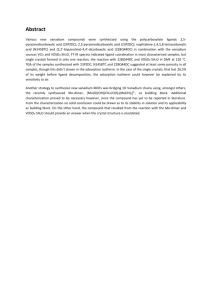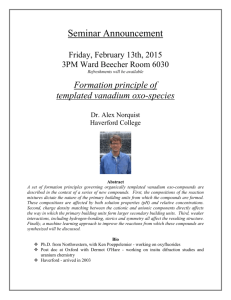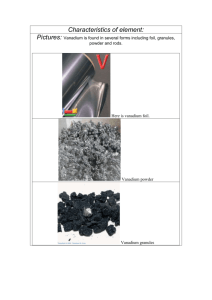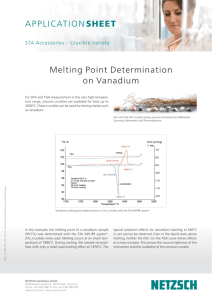PARTICULATE by (1963) SUBMITTED IN
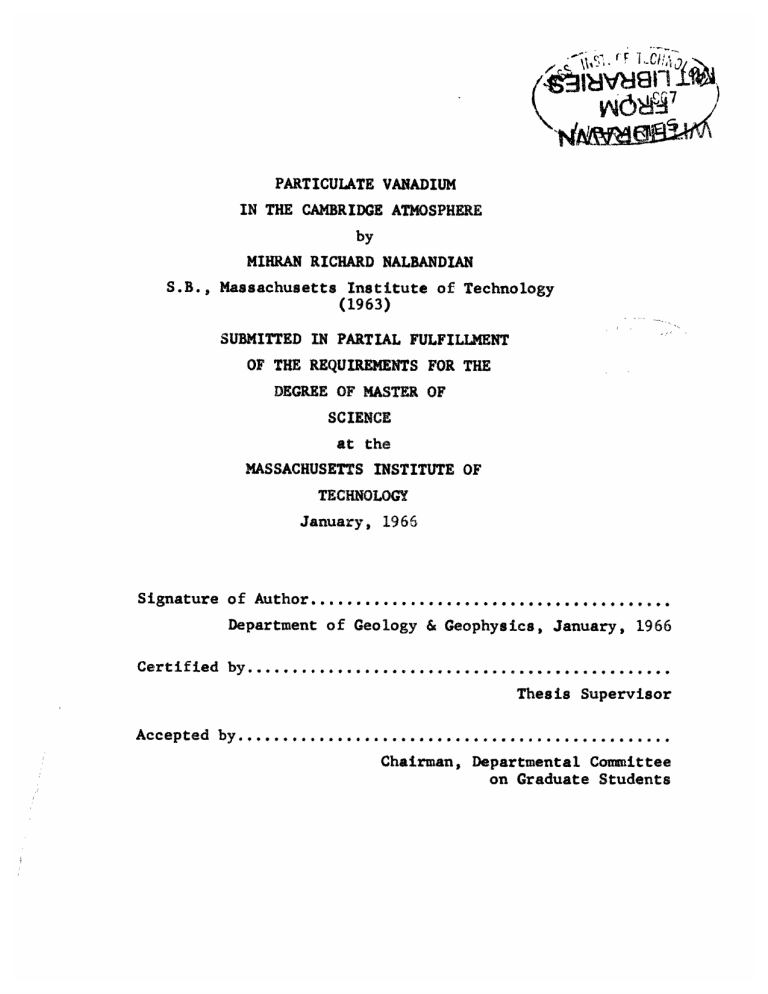
PARTICULATE VANADIUM
IN THE CAMBRIDGE ATMOSPHERE by
MIHRAN RICHARD NALBANDIAN
S.B., Massachusetts Institute of Technology
(1963)
SUBMITTED IN PARTIAL FULFILLMENT
OF THE REQUIREMENTS FOR THE
DEGREE OF MASTER OF
SCIENCE at the
MASSACHUSETTS INSTITUTE OF
TECHNOLOGY
January, 1966
Signature of Author......................................
Department of Geology & Geophysics, January, 1966
Certified by............................................
Thesis Supervisor
Accepted by
Chairman, Departmental Committee on Graduate Students
PARTICULATE VANADIUM IN THE CAMBRIDGE ATMOSPHERE
Mibran Richard Nalbandian
Submitted to the Department of Geology and Geophysics on
January 31, 1966, in partial fulfillment of the requirement for the degree of Master of Science.
Abstract
In view of the deleterious physiological effects of vanadium inhalation, and the fact that the ashes of many fossil fuels are particularly rich in the element, it was decided to determine whether particulate V levels in the
Cambridge atmosphere have yet reached pollution threshold values. 62 samples from January, April, July and October of 1964, were analyzed for V by means of D.C. arc emission spectrography. The mean values (in g of V205/m
3 air) for the above months were respectively: 2.37, 1.52, 0.74, and 1.63. The maximum value for an individual sample was
4.88, which is only 21.3% of the pollution threshold value estimated from the accepted industrial threshold limit value (no air pollution limit value for V has yet been adopted). However, it is believed that a significant upw.ard trend in V levels is in evidence from examination of a few analyses available from 1958.
Future studies of specific sources of the V, and of shortterm and seasonal variations in its abundance are suggested.
Thesis Supervisor:
Title:
William H. Dennen
Associate Professor,
Professor of Geology
Table of Contents
Page
ABSTRACT
Section
1. Introduction
2. Distribution of V in Nature
2.1 Properties of V
2.2 Presence in plants, soils, animals
2.3 Presence in human tissues
2.4 Presence in various marine organisms
2.5 Presence in petroleum and bituminous substances
2.6 Origin of V in petroleum
3. Analytical Procedure
4. Results
5. Discussion
6. Conclusions
7. Suggested Future Work
Acknowledgements.
References
APPENDIX
7
7
8
5
7
7
8
9
11
13
17
19
21
23
24
27
Figures & Tables
Fig. 1.
Fig. 2.
Fig. 3.
Seasonal variation in V content of Cambridge air compared with variation in total soot content. p. 18
Plate calibration Curve (appendix) p. 28
Typical Working Curve (appendix) p. 29
Table 1.
Table 2.
Results of analyses of 62 samples of particulate matter in the Cambridge Atmosphere p. 13
Basic data for analyses (appendix) p. 30
-5-
1. Introduction
The first worker to describe vanadium poisoning in industry was Dutton (1911) .
Since then many investigators, notably Wyers (1946) and Sjoberg3 (1950,1956) have made detailed studies of the effects of exposure to vanadium pentoxide and vanadate dusts. These workers decided that among these effects are bronchitis, pneumonia, conjunctivitis, rhinitis, pharyngitis, and laryngitis, but that there was little or inconclusive evidence as to the presence of systemic poisoning. For an excellent review of the biochemistry of vanadium and its physiologic effects, the reader is referred to: Vanadium, Toxicology and Biological Significance by T.G. Faulkner Hudson, El- sevier Publishing Company, Amsterdam, New York, London
(1964)
4
Of more direct pertinence to the present study is the fact that many investigators, but again principally Sjoberg (1955) have discovered abundant evidence for the causation of vanadium poisoning, bronchitis, and related disorders (possibly even emphysema) in men engaged in the cleaning of oil-fired boilers. Since the soots of heavy residual fuel oils are quite commonly rich in vanadium compounds (see section 2.5), the explanation of the source of the vanadium presents little difficulty. In view of this, the present writer felt that an increased consumption of these heavy, possibly V-bearing, oils in industry and in homes might produce sufficient pollution
of the air of the city with vanadium to cause a public health hazard to exist, or at the least to cause physical discomfort. It was therefore decided to attempt to measure the vanadium concentrations in the particulate matter present in the city atmosphere, in this case
--
Cambridge, Massachusetts.
2. Distribution of V in Nature
2.1 Properties of V
Vanadium (V) is a hard, brittle, steel-grey metal with a melting point of 17100 C, boiling point of
30000 C, and specific gravity 5.96 (200 C). Its atomic weight is 50.95, atomic number 23, and it can have a valence of +2,+3,+4, or +5.6
2.2 Presence in plants, soils, animals
Vanadium is virtually ubiquitous in soils, where its content is 20-1000 g/ton V (Mitchell, 1944) , and also in plants, Bertrand (1941) having detected V in all 62 specimens of various fruits, vegetables and plants which he studied. V is apparently also a frequent using a chemical method with a sensitivity of 0.02 p.p.m.
V, dry weight, found a mean of 1.2 p.p.m. V in invertebrates, and 0.2 p.p.m. in vertebrates.
2.3 Presence in human tissues
Using both chemical and spectrographic techniques,
Perry and Perry (1959) 0 found V in human urines, collected over 24 hours from healthy subjects, in amounts varying from less than 1 ftg/l to 22 gag/l and averaging
11
6 /Ag/l. Tipton (1960) measured various trace elements in human tissues; the tissues examined were the aorta, brain, heart, kidney, liver, lung, ovary, pancreas, prostate, spleen and testis, all of which appeared macroscopi-
cally normal. V could sometimes be detected in lung, liver, prostate, and spleen, but only seldom except for the lung, where it was found in about half the specimens.
The average concentration in these organs was usually less than 1 Ag of V/g of ashed material, but in the lung from some non-traumatic cases it was as much as 5 /xg/g, and in one case 108
1 jg/g.
2.4 Presence in various marine organisms
Several marine organisms are known which are able to concentrate exceptionally large amounts of V from sea water, where it comprises only 0.0003 g/ton sea water
12
(Rankama and Sahama, 1950, p. 290)2. Some holothurians, which are creatures belonging to the phylum echinoderma,
(e.g. Stichopus Moebii, the "sea-cucumber"), and ascidians, "sea-squirts" belonging to the family of tunicates, contain V in their blood (Rankama and Sahama, 1950)12
The blood of the ascidians contains 10% V in a 3% solution of sulfuric acid, and the content in the blood of the holothurians is 10.4% V. Many of these creatures probably accumulate the element not only in their blood, but also in their gut and other tissues.
2.5 Presence in petroleum and bituminous substances
Vanadium is found in most crude oils, asphalt, and bituminous rocks, occurring as oil-soluble porphyrin complexes which are stable against chemical and physical agents and consequently prevent the removal of vanadium from the rocks. A Persian crude oil contains as much as
-9-
2.82%; some coals from Argentina contain up to 21.4% V in their ashes; the mazzimum content of asphalt ashes is
43.4% V; and up to 75% 205 (42% V) may be present in the ashes of some Venezuelan crude oils. 12
2.6 rigin
of V in
Vinogradov (1943)13 believes that V was concentrated from marine muds into the protopetroleum of certain oil-bearing regions of Russia, some of which show extremely high concentrations of V in the crudes, while it is absent in the crudes in other provinces. At first glance, and in view of the above-mentioned presence of large amounts of
V in at least some marine organisms, one might suspect the source of the V to be simply the breakdown of the bodies of these V-rich animals which fall to the bottom of the sea and are incorporated into the marine sediments. However, it appears that the content of V in alum shales is not proportional to the content of organic matter.
1 ~ Instead, the V content of bioliths depends on both on their porphyrin content and on the content of V in weathering and other solutions supplied to the biolith (Bader, 19379.'
According to Bader the formation of bioliths rich in V starts with the precipitation of V derived from weathering solutions as V2 5 and is followed by the formation of organic V complexes, particularly the perphyrins. However, it seems reasonable to this writer that V may be supplied to the protopetroleum both directly fror the death of V-rich marine animals, and from the fixation of
V from weathering solutions by the porphyrins already present in the sediments or waters of the sedimentary basin in which the deposits are forming.
3. Analytical Procedure
Analyses of the particulate matter present in the Cambridge atmosphere in the months of January, April,
July and October, 1964, were carried out by means of D.C.
arc-emission spectrography. Samples were collected on
1 inch diameter glass fiber filters with an efficiency of 99.97% for particles greater than 0.3 micron. The samples were collected for 24 hours except on weekends, when the machine was left running for 72, or even 96 consecutive hours. The samples were weighed, and then stuffed into 3/16 inch diameter spectrographic purity
(no detectable V) graphite electrodes drilled to a bore of 3 mm dia. and 12 mm depth. Standards of concentrations 10,40,100,400 and 1000 p.p.m. by weight were prepared by mixing V
2
0
5
(spec. pure) and National Bureau of
Standards Sample No. 93, a high-boron glass powder with no detectable V present, whose composition was equivalent to that of the glass filters used. The standard powders were tamped into 3/16 inch diameter spec. pure graphite electrodes (whose weight empty and loaded were recorded to determine exact standard weights) drilled with a bore of 3 mm diameter and 5 mm depth, since it was found that approximately 50 mg. of standard could be thus accomodated and the scale factor between the weights of standard and sample could be minimized, the samples (filter + soot) weighing between 48.1 mg. and 55.6 mg. Standards and samples were then arced to completion at 6 amperes in a
low-velocity air jet with the sample or standard as anode and a 3/16 inch "spec-pure" carbon rod as cathode. The spectrograph used was a Hilger large quartz spectrograph.
The wavelength region from 2700
A
to 3400
A was recorded on Kodak Spectrum Analysis-1 plates. Calibration of the first three plates was accomplished by logarithmic step sector (1:1:2:4 in 1.5 mm steps) and thereafter checked
by using a sector with only 2 steps (1:1, 1:4) of height 1.5
m.M, so that more spectra could be recorded on each plate.
Optical density readings were made with a Hilger non-recording microphotometer. Plate calibration curves were constructed by the preliminary curve method, (see appendix), and working curves for each plate were constructed from the standards on that plate in the usual manner.
Concentrations were computed in p.p.m. by weight V metal in the total sample (filter + soot) and then corrected for the appropriate dilution factors.
-13-
4. Results
The results of the analyses of the 62 selected samples are tabulated below (raw data on each sample may be found in the appendix):
9
10
11
5
6
7
8
Table 1.
Results of Analyses of 62 Samples of Particulate Matter in the
Cambridge Atmosphere
(* denotes weekend sample)
Total
Concentra- Total Amount tion V Amount of V
Date metal in of V compu-
Total Partio- Particulate (in all ted as
Sample Collec- ulate 'atter Matter
No. ted (pAg/m
)
(weight forms) V
2
0
%) (/pg/m 3 ) (,*/m3)
6 Jan.'64
7 "
8
9
10-13
13
14
15
16
17-20
20 "
138.9
256.9
250.0
187.5
168.9
145.8
118.1
118.1
131.9
189.8
97.2
0.87%
0.44
.68
1.46
.69
.50
1.23
1.60
1.33
.67
1.52
1.21
1.14
1.70
2.74
1.17
.72
1.46
1.90
1.75
1.26
1.47
2.16
2.03
3.04
4.88
(max.)
2.08 *
1.29
2.60
3.38
3.13
2.25 *
2.63
-14~
12
13
21 "
22 "
14 23 "
15 24-27
16 27 "
17
18
28 "
29 "
48.6
187.5
222.2
168.9
118.1
125.0
90.3
19 30 " 145.8
20 31/1-Feb.3 101.9
21
22
23
24
1 Apr.'64 208.3
2 "
3-6
6 "
111.1
131.9
145.8
194.4 25 7 "
26
27
8 "
9 "
28 10-13
29 13 "
30 14
31 15 "
32 16
33 17-21
34 22
138.9
131.9
132.0
138.8
166.6
111.1
83.3
126.7
104.1
35
36
37
38
39
23 "
24-27
131.9
129.6
27 " 131.9
1 July'64 194.4
2-6 97.2
1.08
.52
.95
.80
.51
.24
.56
.85
.51
.58
.61
.46
.30
.14
.35
1.33
.40
.85
.59
1.07
.59
1.71
1.03
.63
.61
.70
.66
.63
.65
.75
1.89
1.01
1.26
.74
1.54
1.51
.64
1.26
.78
.88
.92
2.10
.72
1.25
1.05
.71
.40
.62
.71
.65
.60
.81
.59
.40
0.28
.34
1.15
1.35
3.38
1.79 *
2.25
1.32
1.29
2.24
1.88 *
1.27
.71
1.10
1.27
1.16 *
1.07
1.44
1.06 *
.70
.50
.61 *
2.75
2.69
1.15 *
2.25
1.39
1.56 *
1.65
3.76
-15
/
/
I
/
40
41
42
43
44
45
46
47
48
49
50
51
52
53
54
55
56
57
58
59
60
61
62
6
7 "
8
9
10-13
13
14
15 "
16
17-20
20
21
22
1 Oct .'64
2-5
5 "
6
7 "1
8
9-13
13
14
15
222.2
194.4
215.3
131.9
81.0
159.7
76.4
194.4
145.8
173.6
69.4
76.4
69.4
173.6
64.8
201.4
173.6
201.4
284.7
126.7
152.8
159.7
194.4
.29
.18
.47
.18
.22
.30
.24
.39
.60
.22
.80
.14
.27
.30
28
.54
.70
.89
.84
.16
.63
.89
.53
2.77
.98 *
.58
1.95
1.08
1.42
1.22 *
1.92
2.55
1.83
1.20
.85
1.50
1.42
.42*
.52
.64
.62
.58
.68 *
.99
.19
(min.)
.33
Note: (The form in which the V occurs depends on the burning conditions of the oil: the di-i, tri-, tetra-, or pent-oxide may be present, as wel as the sulfides and sodium vanadate. However, common practice is to
.19
1.55
.54
.32
1.09
.61
.79
.68
1.08
1.43
1.02
.24
.29
.36
.35
.33
.38
.56
.11
.67
.48
.84
.79
express all V as V
2
0
5
, even though the effects may not always be due to the pentoxide.)
The average values for the four months, selected as presumably representative of their respective seasons, are: January -- 2.37 /. V April -- 1.52 ^ g/m
July --
3
0.74 ,tg/m ; and October 1.63
fxg/m
3
5. Discussion
The similarity between the values for the spring and fall coupled with the fact that they are intermediate between the high average value for the winter month and low value for the suuer month is particularly interesting to the writer. Also of interest is the lack of any significant variations between weekday and weekend values.
Two reasonable alternative explanations present themselves: (1) Due to marked seasonal variations of meteorologic conditions, dispersal and/or fallout (and/or "washout" due to precipitation) rates of particulate matter in the atmosphere differ so greatly as to produce the extreme seasonal variation seen in this study; or (2) the seasonal variation in the V content of the air is attributable largely to the variations in the use of heavy fuel oils in the heating of homes, utilities, etc. Explanation (1) seems to this writer to be ruled out simply because of the following average total soot concentrations for the four months in question: January
--
150.6
3 pg/m ;
3
April --
136.4 pg/m ; July
--
140.1
3 yg/m ; and October --
173.3 sonal variation in total soot content of the air, as there is in V content and no explanation of the marked difference between V content variation and total soot content variation seems possible at this time. (see Fig. 1)
-18-
-19-
6. ConAcLus ions
The threshold limit values for vanadium adopted at the American Conference of Governmental Industrial
Hygienists in 1961, and now generally accepted in countries of the western world and eastern Europe are:
V
2
0
5
(dust) 0.5 mg/m 3
(500 /Ag/m )
V20
5
(fume) 0.1 mg/M3
Ferrovanadium (dust) 1.0 mg/m 3
4 15
However, several workers (Hudson, Lewis (1959),
GulkoI 1 956)) have advocated lowering these limits, probably to 0.1 mg V
2
0
5
/m
3
.
The above organization sent a letter to its members in January 1966, advising them that
0.1 mg/m3 will be advocated at its meeting in May, 1966
(Chamberlin, personal communication, January 1966).
The above threshold limit values are those based on exposure of healthy workers to the industrial environment on a 40 hour per week, 50 week per year basis and therefore must be divided by a scale factor of 4.368 to allow for the breathing of potentially-polluted air on a
168 hour per week, 52 week per year basis. (However, this does not allow for the aged, or the infirm, particularly those with already pronounced respiratory ailments, as do normal pollution threshold values. No air pollution
thresholds have been generally accepted for vanadium as yet, however, and we must "make do" for the time being with the values directly scaled from industrial limits.)
This would give us a threshold value of 22.9 ,
1 ug V 20 5/m 3
(assuming the 0.1 mg/m3 is adopted as the industrial limit value). On examining the results of the analyses we find that the maximum value recorded (Sample no. 4, January 9,
1964) of 4.88 /vxg/m3 is about 2.1% of the threshold value, and that the minimum (Sample no. 51, July 21, 1964) of
0.19 /g/m3 is a scant 0.83% of the threshold.
Obviously, the content of V in the particulate matter of the Cambridge atmosphere has not yet reached pollution levels. On the other hand, measurements of V were made spectrographically in 23 samples of the particulate matter in the Boston air in 1958, and they showed a maximum value of 1.20 *g/m 3
17. It should, therefore, be noted that the maximum value in the 62 samples studied
by the writer was more than 4 times the maximum value of
1958, and that the mean of all 62 samples was 1.62 /ag/m3 in itself an increase of 35% over the 1958 maximum. It appears that there is at least a strong possibility of a significant and, indeed an almost alarmingly rapid, upward trend in the V content of the particulate matter of the
Cambridge air, and that there is a reasonable possibility that pollution levels may ultimately be reached.
7. Suggested Future Studies
An explanation must be found for the anomalous seasonal variation in the V content of the air as compared with the relative constancy of the total particulate matter content. In view of the very high V concentrations in some fuels, it seems reasonable to assume that only a small amount of such fuels relative to the total fuel consumption need be burned at any one time to produce an anomalous V level in the air. Therefore, the identification of the source of the V-rich soot must assume a high priority on any list of future studies of the problem. Whether any particular sector of the city's environment is responsible must be determined. This would presumably be done by the investigation of on-line times for generators and factories, by determining the nature and amount of fuels used by the various components of the city, i.e. home heating plants, utilities, industries, shipping in Boston harbor, diesel-powered vehicles, etc., and by analyzing these fuels and their residues for
V.
This would also imply the establishment of some sort of regular monitoring system for V, and since monitoring systems for air pollution are already in operation, the further implication is that improved analytical speeds must be attained so that large numbers of analyses can be made on a regular basis. Spark emission spectrography holds some real promise in this respect.
r
Finally, meteorological records must be examined to determine the effects of weather on the levels of total particulate and V content in the air.
-23-
Acknowledgements
The writer gratefully acknowledges the invaluable assistance rendered by the Occupational Medical
Service of the Massachusetts Institute of Technology, Dr.
Harriet L. Hardy, Assistant Medical Director in Charge.
In particular, Mr. S. Levin and Mr. F.J. Viles, Jr. generously provided the samples which were analyzed, and Mr.
R.I. Chamberlin and Mr. G.W. Boylen, Jr. suggested and loaned helpful reference materials, as did Dr. Melvin
First of the Harvard University School of Public Health.
A special vote of thanks must go to Professor William H.
Dennen, Director of the Cabot Spectrographic Laboratory of the Department of Geology and Geophysics, M.I.T., for both his excellent advice and his encouragement while the project was being carried out. Finally, to my good friends and colleagues in the Cabot Lab., Mr. William Blackburn and Mr. Antonio Quesada, for their encouragement and technical suggestions, sincere thanks.
"24
References
1. Dutton, W.F. (1911) Vanadiumism. J
~ med. Op
Vol, 56, p. 1648.
2. Wyors, HI. (1946) some toxic effects of vanadium pentoxide. Brt J. j3gmt.!t. o.3 .17
3. Sj'6berg, S.-G. (1950) Vanadium pentoxide dust. A clinical and experimental investigation of its effects after inhalation. -et med. sc~A4d.
(Suppi. 238), Vol. 138.
, -(1956)
Vanadium dust, chronic bronchitis, and possible risk of emphysema. A followup investigation of workers at a vanadium factory.
Acta mod. ssad., Vol. 154, p. 381.
4. Hudson, T.G.F. (1964) Vanadium, Toxicolg and BioloicS ~icaLfgce. Elsevier Publishing Co.,
Amsterdam, London, New York.
5. Sjb~berg, 5.-Gn (1955) A.t.&,
Archives of Idustrial
Health, Vanadium Bronchitis from cleaning Oil-
Fired Boilers. Vol. 11, p. 505-512.
6. flandbook of Chemistr and Physis.
(1953-54)
35th ed.,
Chemical Rubber Publishing Co., Cleveland.
7. Mitchell, Rd.. (1944) The distribution of trace ele-
ments in soils and grasses.
Pro.2i\tSition
Soc. fngI,-and Sco Vol1. 1,j p.* 183.
8. Bertrand, D2. (1941) Recherches sur le vanadium ches
les veoge~aux. jrn* biol., Vol. 23, p. 391. (referred to in Hudson)
9. Bertrand, D. (1943) Sur la diffusion du vanadium chez les invertiebris et chez les vert6br6s.
gog. Chim,
0ul.
piol., Vol. 25, p.
36,
(referred to
in Hudson)
10. Perry Jr., H.M. and Perry, E.F. (1959) Normal concentrations of some trace metals in human urine: changes produced by ethylenediaminetetraacetate.
J. cli. Invest., Vol. 38, p. 1452.
11. Tipton, I.H, (1960) The distribution of trace metals in the human body. Metal Binding in Medicine.
Lippincott, Philadelphia and Montreal.
12. Rankasma, K. and Sahama, Th.G. (1950) Geochemistry.
U. of Chicago Press, Chicago and London.
13. Vinogradov, A.P. (1943) Biogeochemical research in the U.S.S.R., , Vol. 151, p. 659.
14. Bader, E. (1937) Vanadin in organogenen Sedimenten.
1. Die Grunde der Vanadinanreicherung in organogenen Sedimenten. Zentr. Mineral. Geol. A., p. 164.
15. Lewis, C.E. (1959) The biological effects of vanadium.
2. The signs and symptoms of occupational vana-
dium exposure. Ac. industrial H!lth, Vol. 19,
p. 497.
16. Gulko, A.G. (1956) Zur Charskteristik des Vanadiums
als Industriegift.
p. 24.
i. ant. Vol. 21,
r
17. Air Pollution surements of the National Air Sampling
Network. Analyses of Suspended Particulates,
1957-1961. U.S. Dept, of Health, Education and
Welfare, Public Health Service, Division of Air
Pollution, Pub. HIth. Svc. Pub. No. 978, Table
2.45.
Location of Boston Sampling Station: 40 feet above grou.nd level at the Eealth Dept. Bldg.,
I Haymarket Square, State Dept, of Public Health.
APPENDIX
-Hff
tThI~
Hif
.4
m
H+H
.
'
-4
I I
E141+1i.
+1++*
+
T _I i-N1-
I1741-11
~-H
-1---H
1 1 1+1
I II
-H-H 1
*.El
II III I
~4444
T~4
U I I I I I i if
17
TTT F1
I I L Hil
( I
+
L-Li0i
4
9
0,;
F-
171
~i
C
S.
F727F7:Tm:
I4.N44444.44144lI-4444444-44
I I I q#E
-7-".-
I f l f il il-r -
-1 f
-in
4.-
'I I I
-~
JH i
U-J-442-7-.7..t-
1 1 7-
It
If lt i l
1
I jaw
~-7~t7 -4.7
L_ L
I I I l l f i
-
N
IN
I X
::F
I I
L"
IL -14 l t l i
I I
I I
A I I
\ I
~
1 11111 I I
FEh
HIN11
I I I I
+
71- t i
-
IIII II
11 (t 1 !7 1
71-Ur lilt l ifl+Flfl_ "
.LL..LL I~2 .1
__
L.LU i'IU I
F
_
.L. r-11H41±p-f+--14-Th
T
i-I+h H-
UFT~7F7TT 2Th7;
~-h4-h-h-~
I f i t I ! I I I I i f
-
I
J2
8 L 9
rnr~hmnCIai~S
0* 09 0 001E#OA uO4D"qi1b
'84td
9A#l'
*J"!
If
11 I i IL I I H II i
FFJ+EHIFP
IT I I I jJ1111111111 I
"1
1 1 1 D. 1 .1-11 Lt§_ iLLL
I;;
~itTh+H4
~T
2
"a 0"s 0"
AF77PPVF
H~-H-ITh-~-I Th~-H-H-~.H-~-~--I-H-H-H
-~
+4IA++~LA+~I+H
~ZW~ ~ = I
'ox~A
Qvm
I tA-1
Sample
Jun
6 er
-30-
Date
Collected
Table, Z.
Weighit o4 SAMple
Basic.
We ikt
o.f Goat
(MOt
'Data
Volume
of Air o.
6Z
conC.C-trati~j
Ahalyses.
onc
Of V 1. S4ile .ect f,
Veo.
ost Wt.
3 95
3z5
363
32S/
/0
2
3
6 jLauary'f Y9.4
7 .. ..
8
.. ..
51./
51.0
9
.. .. ./
10-13.. .
54.7
/3 ..
..
99.5'
if
.. ~ #9./1 7
8
91
40
//1
I'
.. .-
9Y9.3
/7-2o.0 .
20 ..
2/
..
..
..
56
98.8
4'8/
/3 zz
.. ..
5o./' zS ~ .. 610.6
Is, it,
(weekend.)
/6,
24-27.. .. 547
27 .. .. 9/
Z.. 49.1
/p
20
2/
22.
Z2 ..
30.. ..
31!5lah.3PFe
98.7
'.9.5
51.8
1 Apri'' 5'0,5
S..
..
9.0
.. .. 53.
-6
(wteeked.
2//
7 .. ..
50.2
2.1
3.9
/.16
67
Z./
Z.6s
/,7
/47
/.9
8.
/.y
o.7
2.7
3.z
7.3
/.7 ,
1.
2.0
3.7
3.6
Z.7
7.3
/941
-.
413.2
4,.9
It
'/3.2
#4.2
780
/000
Z06
786
923
ZI/C
9/5
S4'o
'/27
6555
600 5~2
/080 izo935
-98/
/89
2/5
890
/93
2/7
53.9
860
360
799
370
'/40 456
430 *39
95,o 636
360 36/ ozzz 229
76-0 7/3
243
600
248
60
Notel: Mean weigAt qf 10 bla
4 k
/ifter-s was 97 ceviabon of //Z Z
NVA. Z : Mlean we'./11A
of standards for sungles |-Z5 was
5:'O.' mf .
-31-
Numbe)-
.sa:te: ro'hSI g26
Date
CP/.tae.
able
a.
Basic Data
of 62
Ahalyses (cnt.).
Ver-
Weigh7 Weight VolUmse Cnchftra-t'* tei'.ae f snaros of Sam~p/e of Soot of Air of
Viii
(~~.
(q.-) (MY.) (3 ppm)
/4A 8 April Zy Z5. 1.5 /20 29'
26
.. ..
27 9 "1
Z.7 it o
.- 24.2
25,3
2-Y, 0
0.5
/.6
0,3 I,
" to
84'
Z/5
/O0
/77
433
297
Z8
(weekend)
10-13 t.
z8
(we-kend)
.- '.
Z,9
/3 o
26.Z
26,9
2.6,
3.2
/1.0
4'3.Z
ii
1*4'
4160
//0
6741
833
/27
2,.7
9'Z
Z9 ,. 1.0
I, 190
3o /4 -'
169
//
30
"
.. 2 7
/.0
45-4
/. 0
Z/o
3/
31
/S" to it t
0.6
73 /53
0, Y 237
32
/'
-
/83
-25! S
0.9' 4(00
33
(4-day weekhend)
/7-2/ -
-29.3
3.5 5 79.9
336'
6zo
3.8
/1
('/-day wee.and)
341 2Z ..
a 297
35 Z3 .
..
272 a Z7.S3
-257
1 z o.3
18
/Y.9
98
72
/26
20o
/53
ZSZ
220
35 ,.f
0./ /03
36 2'V-27..
(wee.ked)
36
(weekendr) i..-
37 Z7 to
37 f ..
3.6
2.0
0.3
1.6
''
Z75
228
5-3
S-9
5/3
4'52
IZ
119
-32-
3/mbe-
38
3.9
(-dy weekend)
/o
Tale 2.. Basic Data
of (Z
Analyses (cant.).
Collected of Sam>/e of' Soot
Vo/ume of Air
Cocentmhruf.
cone. Vcarre.*d
(p"PM.)
79 liu/y'
so~x
2.8
(m3)
14
80
37Y
6 .. 53.0
6-7(o 390 aa.
.. So.6 3.Z
/S.9
190 /9'
/37 4,
#fZ
/3
411
(weekaend)
95
7
8
9
-
.. io-13 ..
/3
.
0 .
So.2 2.8
9.3 o.9
49,7
3./
/.9
3.5
2.3
'I
93.2,.
"'.4
Z38
ZOZ
83
239 zZ
85'
4(7
#7 /r.. -o 5o.z Z.85
1, do
/Z
986
/07
99
99
16 .. --
"/9,5
2
92,
19 /7-20 -o 9.9 7.5
3Z5 30/
/66
5/0
Z o .. .. 981,0
2/ -.
5./
/58
3/ 3Z z2
.. .. .9 1.0
53
56
S3
5u/
(eekend.)
5
',
/ ostfber'4 99,9
2.-S" -o --- 5~O.2z
5
.. .. 5 .3 2
.~
Z.6 a
7
.. .. Y9.9
7 ..
2.
O -- o3 29
58 8 .. a.
5/.5"
59 9-13 ..
57 7.5
'3 .. ..
6/
~z
/~..
9,6 Z.3
..
5o.z
2 2.8
$1
576
'9, 9
'I
"/65~
92.
3/o
/72
22-6
775
305
/051
290
998
97/
93
3/6
/79
2z
72o
3/2.
4/9
295
293
